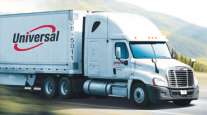Earnings Jump at Truckload Fleets on Higher Rates, Freight
This story appears in the Feb. 6 print edition of Transport Topics.
J.B. Hunt Transport Services Inc. and Werner Enterprises Inc. continued the parade of truckload operators whose fourth-quarter earnings rose with help from higher rates, stronger freight trends and key businesses such as intermodal.
Net income climbed 25% to $72.6 million at Hunt, Lowell, Ark., from $57.9 million as revenue rose 18% to $1.20 billion. Werner, Omaha, Neb., improved net income to $29.4 million from $24.1 million, a 22% increase. Revenue climbed 10% to $507.9 million.
The results at Hunt and Werner followed higher earnings reported last month by five truckload carriers and continue the trend of improving industry results on a year-over-year basis for the ninth consecutive quarter. In the less-than-truckload sector, Arkansas Best Corp. and Saia Inc. also reported better results recently.
“Fourth-quarter 2011 freight demand . . . was better than fourth-quarter 2010 and showed more traditional seasonal trends,” Werner said in a statement. “Our freight demand progressively improved from September to December, before the normal seasonal decline, which began during the second week of December.”
Werner’s statement also said capacity constraints were strength-ening the market for freight more than underlying demand.
In contrast to Werner’s assessment, Hunt’s freight volume increased about 6% to more than 865,000 shipments. Intermodal accounted for nearly 90% of the increase.
Hunt’s intermodal volume rose 17%, including a 35% increase on moves east of the Mississippi River, and rates rose 4.6%, enabling the carrier to boost intermodal revenue to $729 million. The intermodal freight moves produced $83.9 million in income before interest and taxes, and 69% of the company’s total operating income of $122.3 million.
“The demand for conversion from highway to rail continued to be strong,” Hunt’s Jan. 27 statement said. “Cost increases in both rail and [truck] purchased transportation, container cost and fuel were offset with customer price increases, fuel surcharges and a lower percentage of empty repositioning moves.”
Dedicated revenue rose 9% to $260 million, while the truck unit revenue rose 8% to $128 million and brokerage revenue climbed 19% to $99 million.
Profit for the dedicated business before interest and taxes was $27.4 million, an improvement of 40%, while the truck unit’s earnings on that basis rose over 60% to $7.1 million and the brokerage business raised its income by 25% to $4.1 million.
Dedicated carriage boosted profit before interest and taxes because of lower costs, higher revenue per truck per week, which rose about 2%, and a 6% increase in fleet size.
Truck unit profit at Hunt was helped by a 4.1% rate per mile increase, excluding fuel surcharges, as well as expense savings and higher gains on equipment sales. Increased driver and contractor costs held down the profit increase, the company said in a statement.
Hunt’s brokerage business also was helped by higher demand and rates.
Other truckload fleets have also reported an improving market.
“The fourth quarter was good, and volumes have remained strong in the first three weeks of this year,” said Jim Richards, president of refrigerated carrier KLLM Transportation Services, Jackson, Miss. “We are optimistic.”
Richards told TT the volume in 2012 was a positive sign because in the past there often has been a marked falloff after the end of the year.
When asked about the reasons for a stronger market, he said “the economy seems to be moving a little better.”
At Werner, trucking business revenue per total mile rose 4.6%, with help from rate increases at times of peak demand. The increase excludes fuel surcharge collections.
Total trucking miles operated fell 4% at Werner, which relied on its non-asset based Value Added Services to handle shipment growth.
Value Added shipments rose 11%, and revenue per load increased 13%.
Those increases included a 19% rise in brokerage revenue, 9% higher brokerage shipments and a 75% increase in intermodal revenue.
Werner reiterated its intention to keep its truck count at approximately 7,300, while also acknowledging that “our truck count has operated slightly below this level due to the increasingly challenging driver market.”
The average fleet size as the fourth quarter ended was 7,200.
“Assuming the domestic economy strengthens in 2012, we anticipate the driver market will become even more challenging in 2012,” said Werner’s statement.




